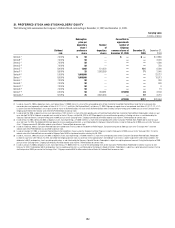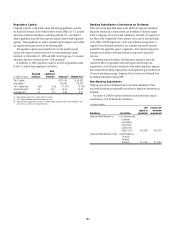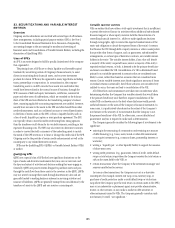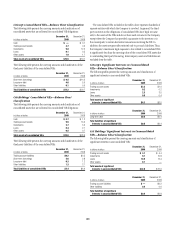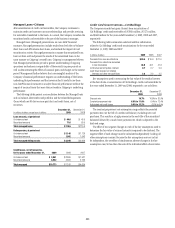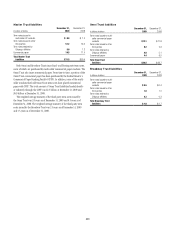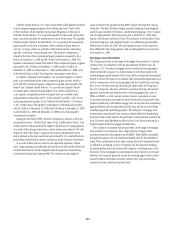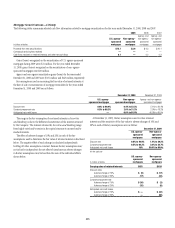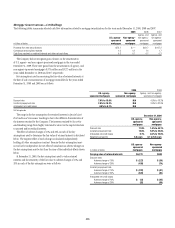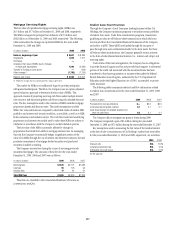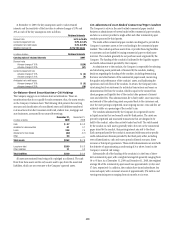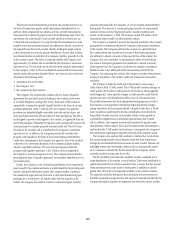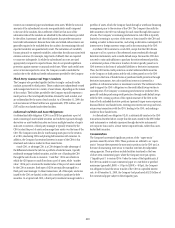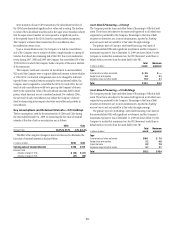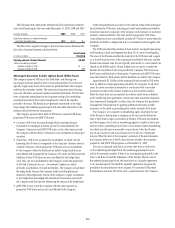Citibank 2009 Annual Report Download - page 212
Download and view the complete annual report
Please find page 212 of the 2009 Citibank annual report below. You can navigate through the pages in the report by either clicking on the pages listed below, or by using the keyword search tool below to find specific information within the annual report.
202
At December 31, 2009, the key assumptions used to value retained
interests and the sensitivity of the fair value to adverse changes of 10% and
20% in each of the key assumptions were as follows:
2009
Discount rate 19.7%
Constant prepayment rate 6.2% to 10.8%
Anticipated net credit losses 13.0%
Weighted average life 11.6 months
In millions of dollars
Residual
interest
Retained
certificates
Other
retained
interests
Carrying value of retained interests $ 786 $ 9,995 $ 2,024
Discount rates
Adverse change of 10% $ (42) $ (10) $ (6)
Adverse change of 20% (83) (20) (12)
Constant prepayment rate
Adverse change of 10% $ (49) $ — $ —
Adverse change of 20% (93) — —
Anticipated net credit losses
Adverse change of 10% $(361) $ — $ (48)
Adverse change of 20% (715) — (95)
Managed Loans—Citi Holdings
After securitization of credit card receivables, the Company continues to
maintain credit card customer account relationships and provides servicing
for receivables transferred to the trusts. As a result, the Company considers the
securitized credit card receivables to be part of the business it manages.
Managed-basis (Managed) presentations are non-GAAP financial
measures. Managed presentations include results from both the on-balance-
sheet loans and off-balance-sheet loans, and exclude the impact of card
securitization activity. Managed presentations assume that securitized loans
have not been sold and present the results of the securitized loans in the
same manner as Citigroup’s owned loans. Citigroup’s management believes
that Managed presentations provide a greater understanding of ongoing
operations and enhance comparability of those results in prior periods as
well as demonstrating the effects of unusual gains and charges in the current
period. Management further believes that a meaningful analysis of the
Company’s financial performance requires an understanding of the factors
underlying that performance and that investors find it useful to see these
non-GAAP financial measures to analyze financial performance without the
impact of unusual items that may obscure trends in Citigroup’s underlying
performance.
The following tables present a reconciliation between the Managed basis
and on-balance-sheet credit card portfolios and the related delinquencies
(loans which are 90 days or more past due) and credit losses, net of
recoveries.
In millions of dollars, except loans in billions
December 31,
2009
December 31,
2008
Loan amounts, at period end
On balance sheet $ 27.0 $ 42.0
Securitized amounts 38.8 36.4
Total managed loans $ 65.8 $ 78.4
Delinquencies, at period end
On balance sheet $ 1,250 $ 1,364
Securitized amounts 1,326 1,112
Total managed delinquencies $ 2,576 $ 2,476
Credit losses, net of recoveries,
for the year ended December 31, 2009 2008 2007
On balance sheet $4,540 $ 3,052 $ 1,956
Securitized amounts 4,590 3,107 1,995
Total managed credit losses $9,130 $ 6,159 $ 3,951
Funding, Liquidity Facilities and Subordinated Interests
Citigroup securitizes credit card receivables through three securitization
trusts—Citibank Credit Card Master Trust (“Master Trust”), which is part of
Citicorp, and the Citibank OMNI Master Trust (“Omni Trust”) and Broadway
Credit Card Trust (“Broadway Trust”), which are part of Citi Holdings.
Master Trust issues fixed- and floating-rate term notes as well as
commercial paper. Some of the term notes are issued to multi-seller
commercial paper conduits. In 2009, the Master Trust has issued $4.3 billion
of notes that are eligible for the Term Asset-Backed Securities Loan Facility
(TALF) program, where investors can borrow from the Federal Reserve using
the trust securities as collateral. The weighted average maturity of the term
notes issued by the Master Trust was 3.6 years as of December 31, 2009 and
3.8 years as of December 31, 2008.


